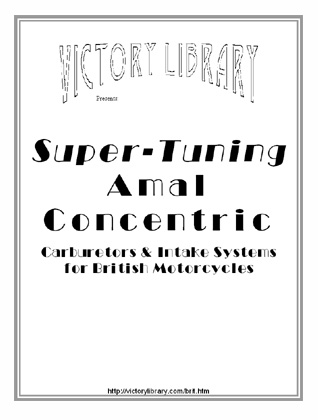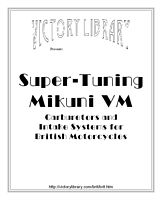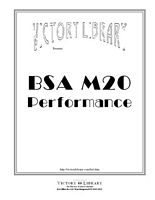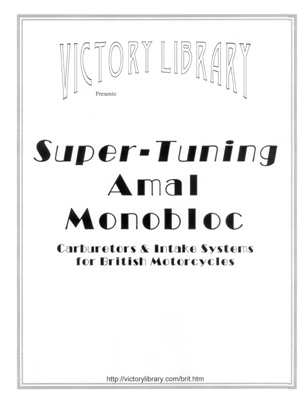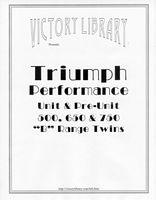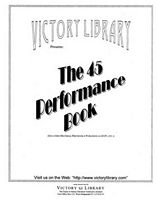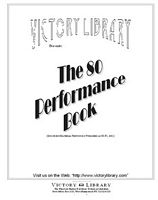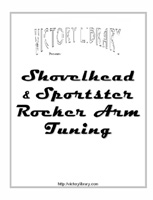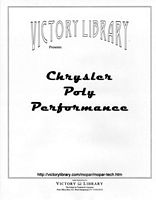|
|
 |
The experienced engine builder (Mopar, Harley-Davidson, or Ferrari) knows that the “advertised” compression ratio (suggested by the owner’s manual, piston manufacturer, &c.) is only one of several factors involved in determining how much pressure is developed in the combustion chamber.
This article discusses briefly how to roughly calculate how changes in either
cam timing, compression, or both affect low-speed torque and response. Some of the more important factors are: |
» |
Theoretical or mechanical compression ratio (advertised, static, or nominal), including corrections made for changes in the combustion chamber volume due to variations in piston compression distance, changes in piston dome shape such as valve reliefs and flame slots, chamber modifications such as larger valve installations, combustion chamber re-shaping, bore notches for valve relief, alternate gasket thickness, head and/or block milling, &c. |
» |
Intake valve closing point (generally the 2nd number in the cam timing data, given in degrees after bottom dead center, or ABDC) |
» |
Internal geometry of the motor |
This last factor is not fully appreciated by most mechanics. The crankshaft’s connecting rod journal (or “throw” ) is offset from the main journal by exactly ½ the stroke length. The geometric relationship between the rod and the rod journal is one not generally understood, but which plays a key role in the motor’s breathing and overall power characteristics.
The ratio of rod length to stroke length (usually represented by the symbol “n” ) is almost always between 2.1:1 on the “long” end, and 1.4:1 on the “short” end. 99% of all motors fall between these 2 extreme limits, with most standard production designs between 2.0:1 and 1.45:1.
An “n” value of 1.75 is considered “ideal” by some respected engine builders, if the breathing is optimized for the design. Except for purpose-built racing engines, most other projects are compromises where 1.75 may not produce the best results. |
The percentage of mixture captured, compressed, and burned in the cylinder at a specific point
of intake valve closure partially depends on the motor’s rod ratio. The piston’s motion during crankshaft rotation is not symmetrical: the piston speed before & after TDC is faster than before & after BDC, but the difference is not constant - it varies with the rod ratio. Two motors with the same stroke, but different rod lengths, will not have the piston in the same place at the same point of crankshaft rotation. The only 2 exceptions are 0° (TDC) where both strokes are zero, and 180° (BDC) where both strokes are equal & nominal.
By the way, the usual limit of engine speed based on the stress of the reciprocating components is not RPM, it’s piston speed. The formula is: |
P = S × R ÷ 6 |
where “P” is piston speed in feet per minute, “S” is the stroke in inches, “R” is engine RPM, and 6 is a constant. About 4,000 f/m is safe for good-quality cast pistons and up to 5,000 f/m for forgings, for peak power only - shifting, not cruising! |
Since this speed is not constant throughout the engine’s rotation, piston speed is only an average. A better method of calculating maximum RPM is based on the point of fastest piston acceleration, and takes into account the rod length (longer rods improve the safe RPM slightly). The formula is: |
Z = N2 × S (1 + (1 ÷ 2n)) ÷ 2189 |
where “Z” is piston acceleration in feet per second, per second, “N” is engine RPM, “S” is the stroke length in inches, “n” is the rod-to-stroke ratio (as described, supra), and 2189 is a constant. A safe limit for “Z” is about 100,000 f/s2, although this will cause ring flutter with 1/16” compression rings.
Long-rod motors (“n” = 1.75 to 2.1:1) will have the piston closer to TDC than the short-rod motor at any point between 90° BTDC & 90° ATDC. Short-rod motors (“n” = 1.4 to 1.75:1) will have the piston closer to BDC than the long-rod motor at any point between 90° BBDC & 90° ABDC.
Short-rod motors have slower
piston movement upwards away from BDC on the compression stroke, and will capture
more mixture at the same point of intake valve closure. This makes them
more tolerant of extended (late intake closure) cam timing.
Longer duration cams generally need more static
compression. The usual cam functions (also known as valve events) are Intake Opening Point, Intake Closing Point, Exhaust Opening Point, Exhaust Closing Point, Overlap, Lobe Separation Angle, and Valve Lift. The only one which affects cylinder pressure directly is the Intake Closing Point - where the intake valve has just closed ABDC at the beginning of the compression
stroke. Intake valve closure after BDC (present in all modern cams) always
causes some of the intake mixture to be compressed backwards out of the
cylinder by the rising piston at very low speeds. Almost all high-performance cams use extended (later) intake valve closure as a method of increasing peak power. Late (radical) intake
valve closure causes some mixture to escape even at moderate speeds, reducing
cylinder pressure during the operating range (at the lower end of the torque curve). The point in the engine’s RPM range where this reversion stops and full-stroke capture (or more!) occurs is frequently the torque peak (never after it), and depends on many factors, including cam timing, port efficiency, mixture velocity, manifold runner & port cross-sectional area & volume, resonance, harmonics, exhaust system design, &c. I have no method of applying math to these factors - it’s too complex!
“Add 15” is from David Vizard’s guess that the common flat tappet race cams are effectively about 30 degrees shorter than their nominal duration: 15° from each end.
With only engine vacuum as the drawing power, .050” duration is useful to determine when the intake port starts working.
However, since the force at work here is the rising piston ABDC, back-flow takes place whenever the valve is cracked open, and trapping (compression) only begins when the valve is fully closed - perhaps 5-10° later than the “plus 15” input.
The JavaScript calculator uses 2 errors in opposite directions, which accidently more or less balance out, but the result does not match actual conditions. Only the most violent ramps have only 30 degrees difference between nominal and .050” duration, which means that the intake closing point input is too conservative (early), resulting in a longer stroke than accurate.
This is balanced by use of 1.1875 as the exponent for the corrected CR, a polytropic value used in preference to the traditional adiabatic value (1.4) for the ratio of variable heats for air and similar gases at the temperatures present. The usual exponential value for calculations is 1.2 to 1.3 depending on the engine.
This low exponent means an (incorrect) longer stroke is multiplied by an (incorrect) lower CR pressure value - but they don’t zero out.
Using VE is pointless - at cranking speed all engines are 100 VE - the effective stroke is filled 100% since there are no intake restrictions. Therefore VE at cranking and low speed is 100. DCR at any speed near the power peak also shows nothing, since reversion back through the intake has (almost) stopped, making the effective stroke the full stroke, and restoring the CR to static +/- VE.
The trapped volume, effective stroke and DCR vary quite a bit with a change of only 10° in the intake closing point.
A valve open only .005” will leak when pressurized, and at cranking speed the leak is fast enough to permit the volume between BDC and IVC to escape almost completely until the valve actually touches the seat.
Some engines with small valves, short cams and rapid cranking speed will be under vacuum and not pull 100% of the effective stroke (100 VE between IVC and TDC), but will also not bleed out all volume between BDC and IVC and have some light residual pressure as the valve closes.
The exponent depends on too many non-quantifiable factors, especially heat loss through the jacket and normal operating temp, but between 1.2 and 1.3 is favored by most calculator authors.
The calculator is best used to predict & compare changes in variables in an individual motor, not as an instrument of measurement, or comparison between different motors. The linear nature of the input data vs. the highly varied conditions in different motors will always result in misleading figures. Even if the intake valve closing point is exact, the amount of flow reversion vs. capture will still vary between different motors due to flow characterictics between valve seats, rocker arm ratios, rocker geometry, valve head shapes, &c.
If you have (or plan to install) a long-duration cam, you can (and should) regain some of this lost pressure by raising the compression
ratio, but the 2 effects do not always “cancel each other out” -
you can’t get something for nothing. Even though a higher compression ratio
will give you back a higher pressure gauge reading, the power may still
be lower, at least at low to moderate speeds.
DCR Errors
“Dynamic Compression Ratio” (DCR) is offered (elsewhere) as a method of approximating how much power will be lost by extended intake closure (i.e., cylinder pressure is reduced). DCR is very useful in predicting what octane is needed at lower speeds to help setting idle (initial) spark vs. advance curve length, stall speed, &c. However, this is only partially accurate due to several errors and misconceptions.
1. The actual power loss is only present below the points where both full capture (where intake reversion ABDC stops) and positive flow-through at overlap occur (although these may not be close together, depending on engine design). Above that point power is increased (over the milder cam), either by improved volumetric efficiency (and cylinder pressure, since a larger percentage is trapped in the cylinder), higher RPM reached @ the same efficiency level, or both.
2. The power loss is not solely due to reduced cylinder pressure (which is the output of the Kelley, RSR &c. DCR calculators), since the lower pressure is also acting through a shorter effective stroke (measured from intake valve closure ABDC) and therefore suffers from two reductions. My own method factors in the effective cylinder displacement as well, for a closer approximate at how much power is developed at low speed.
3. DCR is widely considered to be an accurate barometer of knock resistance (e.g., “up to 8:1 DCR can be used with XX octane”, &c.).
This is not true, and not safe, since (in a high compression motor with its DCR reduced by late intake closure) after the early low-pressure period expires (at the beginning of the torque curve) actual combustion pressure will be at least as high with the bigger cam than it was previously - even though the DCR is lower, and therefore suggests that lower octane is safe. However, in a motor with 14:1 static CR the gas pressure at its torque peak is not at all reduced by a very late intake closing point, although the (lower) DCR may indicate that 92 octane &c. is sufficient.
Since the knock will only occur at high speeds it may not be audible, and will reduce power (lower MPH) even if no damage can be detected. In my opinion, the power sometimes gained by retarding spark in high gear is actually an attempt to recover some of this loss - but would be better served by reducing the static ratio slightly.
DCR is a curve or slope of cylinder (not combustion) pressure, with Position 0 (the absolute low end) at cranking speed, then a small rise to idle speed, then another rise to the capture point &c. After this point (and especially near the torque peak) the static CR becomes more important, since approximately the full stroke length and nominal swept cylinder volume (or more, depending on VE) is captured and compressed at (below, at, or above) the nominal static ratio, regardless of the intake closing point.
Any cam will determine the “slope” (or rate of rise) of the DCR curve. A long-duration cam with its attendant late intake closing point will have a high degree of rise, a mild cam less, &c. A longer cam will also extend (stretch) the range of RPM that the slope covers, sometimes over several thousand more RPM.
The static ratio determines the height of the cylinder pressure line at Position 0 (cranking speed). With high static ratio the entire curve is higher, with the curve’s upward intensity being governed by the intake closing point.
It’s possible to design a DCR that looks promising, but will not provide any more power, by assuming that there is no limit to either static ratio or intake closure - and, of course, neither is true. Some motors cannot turn fast enough (due to stroke length, weak valve gear, high reciprocating weight, &c.) to reach their capture point if the intake closure is too late, and will produce more power with more conservative cam timing. A motor with limited static ratio (flathead) must conserve cylinder pressure by limiting intake closure for the same reasons.
Another error in use of DCR calculations for low-speed power prediction lies in the fact that a smaller volume
of mixture being compressed to a higher ratio. Even though the pressure gauge reading taken during cranking or idling is higher, the total of cylinder pressure times the actual mixture volume captured may still be lower (compared to the original milder cam and moderate compression ratio).
To sum up: DCR a useful tool, but widely perceived to be of greater worth than can be supported by physics.
As a note: the gas present in the combustion chamber @ TDC is presumed to be non-combustible exhaust gas remaining from the previous cycle, and is therefore not included in the mixture volume for our purposes. At high engine speeds (under certain conditions) overlap does cause this remainder to be partially combustible, but this is not true at cranking to moderate engine speed.
In short, a cam change can’t be “cured” completely
by raising the compression ratio, but it’s still an excellent idea. The
“V/P (“Volume/Pressure”) Index” , which is the subject of this Tech Paper, will not predict
maximum torque or power, but still provides useful information about conditions present in the motor at cranking speed. These same conditions generally affects low-speed
response & flexibility, knock-resistance, &c. for spark advance settings, torque converter stall speed selection, axle ratio choices, &c.
Another useful purpose is to anticipate the effect of higher elevation on cylinder pressure. Perform a calculation (as described below) first, then another substituting a lower value than 14.7 psi for “Atmospheric Pressure”. Compare the results to estimate how much adjustment to the nominal compression ratio is needed to (partially) compensate for the lower air density. Click here for a calculation based on differences in atmospheric pressure: 
V/P Index
A reasonable estimate of the relative effects of
compression ratio, rod ratio, and intake valve closing point at cranking speed can be made
by use of a simple formula. Although a “power” (exponent) is used in the
formula, most pocket and on-line calculators have a function to permit
a fractional exponent to be entered (use Microsoft “Calculator” in W2K, &c. It has this feature - to use it, select “Scientific” view). Try it out - it’s
not that difficult!
Given: |
» |
Atmospheric pressure = 14.7 psi (pounds per square inch, or 29.92 inches of mercury). This is a constant for our purposes here at sea level, but should be adjusted downward for extreme elevations.
To convert psi to In. Hg, multiply by 2.036; to convert In. Hg to psi multiply by .0491. |
» |
Intake valve closing point (ABDC). At cranking speed, intake flow reversal still takes place until the valve is actually closed, so the “paper duration” (nominal) closing point is used for calculations. For intake closing points of common MP factory camshafts, click here:  . By the way, at operating speeds the general consensus is that the intake valve is not effectively open until valve lift reaches .050”. . By the way, at operating speeds the general consensus is that the intake valve is not effectively open until valve lift reaches .050”. |
» |
Theoretical compression ratio. I have found that (in general) manufacturer’s nominal compression ratios are a bit optimistic, and that for purposes of calculation about 5 to 10% should be added to the chamber volume as a correction for loose factory tolerances. For example: a big-block 906 head is nominally 78.5cc. In practice, the volume is generally larger, up to 85cc. The calculations made below assume accurate chamber volume - if you're not certain of your actual chamber volume and use your original (nominal) compression ratio when calculating, your actual cranking pressure will be a bit lower than the figures resulting from the formula. Click here to review the factors, as described, supra:  . . |
» |
Stroke remaining at intake valve closing point, which is determined by the engine’s stroke, and rod to stroke ratio (“n”). This is calculated by dividing the rod length by
the stroke length. To find the rod ratio of common Mopar engines, click here:  . . |
Results: |
» |
Corrected (true) compression ratio. |
» |
Cranking pressure, absolute (in psi, zero elevation std.). |
» |
Gauge pressure (in psi, zero elevation std.). |
» |
Corrected cylinder volume (cylinder displacement trapped when the intake valve closes). |
» |
V/P Index |
The V/P Index is a mathematically-derived figure, the product of the corrected volume and cranking pressure. It’s
a useful barometer of the motor’s low-speed power, and may be solved
with new variables for a “pre & post” analysis when modifications are
contemplated. Anyone planning a cam or compression ratio change would definitely want to know
how much the low-speed flexibility would be affected. Some useful insight may also be derived as to the motor’s tolerance of pump-quality gas (ping & knock resistance). The results of
these comparisons are generally quite surprising!
To calculate the V/P Index for a specific motor, you’ll need the exact piston position at all relevant crank positions from BDC to
about 90° ABDC, the compression ratio, and the intake valve closing point. |
If you'd like to calculate piston positions for your own motor, the following formula has been contributed by a reader: |
SE = (S ÷ 2) + R + ((S ÷ 2) × cosA) - SQRT ((R2) - ((S ÷ 2) × sinA)2) |
where “SE” is the effective stroke, “S” is the nominal (full) stroke, “R” is the rod length, “A” is the crank-shaft angle in degrees ABDC from 0 to 90°, and “SQRT” (or “SQR”) is the square root function.
Be sure to copy the equation very accurately, including the “nested” pairs of parentheses. This should work “as-is” for calculators, but most computer programs will require “A” to be converted from degrees to radians: Radians = Degrees × .017453, or Degrees × Pi ÷ 180. |
To make a V/P Index calculation, find your intake closing point from the cam manufacturer’s data. For common MP stock & performance camshafts, click here:  . Locate this figure as the crank position, and take the stroke from that position to calculate the “effective”
cylinder volume (“VE”), which is amount trapped
by the closed intake valve; which is always less than the nominal volume (“VN”).
Using this, calculate the effective compression ratio (“CRE”);
also lower - the combustion chamber volume is unchanged, but the cylinder
volume is less. At cranking speed, the absolute cranking pressure (“CP”)
is a function of the 1.2 power of the effective compression ratio (i.e.,
for 8:1 compression ratio, use 8^1.2)
times atmospheric pressure (14.7 psi @ sea level, &c.). This adjustment (1.2 power) is a polytropic value used in preference to the traditional adiabatic value (1.4) for the ratio of variable heats for air and similar gases at the temperatures present. This compensates
for the temperature rise caused by compression, as well as heat lost to the cylinder. 1.2 is not accurate in all cases, since the amount of heat lost will vary among engines based on design, size and materials used, but provides useful results for purposes of comparison. . Locate this figure as the crank position, and take the stroke from that position to calculate the “effective”
cylinder volume (“VE”), which is amount trapped
by the closed intake valve; which is always less than the nominal volume (“VN”).
Using this, calculate the effective compression ratio (“CRE”);
also lower - the combustion chamber volume is unchanged, but the cylinder
volume is less. At cranking speed, the absolute cranking pressure (“CP”)
is a function of the 1.2 power of the effective compression ratio (i.e.,
for 8:1 compression ratio, use 8^1.2)
times atmospheric pressure (14.7 psi @ sea level, &c.). This adjustment (1.2 power) is a polytropic value used in preference to the traditional adiabatic value (1.4) for the ratio of variable heats for air and similar gases at the temperatures present. This compensates
for the temperature rise caused by compression, as well as heat lost to the cylinder. 1.2 is not accurate in all cases, since the amount of heat lost will vary among engines based on design, size and materials used, but provides useful results for purposes of comparison.
To predict a pressure gauge reading subtract
14.7 (or the correct atmospheric pressure at test elevation) to compensate for the fact that a gauge in free air reads “0”, not
14.7 psi, even though atmospheric pressure is always present.
The V/P Index number
is the product of the effective volume times the effective compression
ratio, times the number of cylinders, times a correction factor weighted
to produce a number roughly proportionate to torque in ft./lbs. at low speed. Please note that this number is best used for comparison purposes (before & after changes in compression, &c.), not as an absolute prediction of engine torque. |
V/P = VE × CP × N × .3%
Symbol |
Meaning |
Definition or Calculation |
B |
Bore |
Piston diameter, in inches |
S |
Stroke |
Full (nominal) crankshaft stroke; TDC to BDC measurement (180° rotation),
in inches |
SE |
Stroke, Effective |
Stroke measured from intake valve closing point (less than 180°) to TDC [always less than “S”, supra] |
VN |
Cylinder Volume, Nominal |
B2 × S × .7854 (1 cylinder) |
VE |
Cylinder Volume, Effective |
B2 × SE × .7854 (1 cylinder)
[always less than “VN”, supra] |
VC |
Chamber Volume |
VC = VN ÷ (CRN - 1). Total volume (1 chamber) above piston @ TDC, in inches. |
N |
Number of cylinders |
(4, 6, 8, 10, &c.) |
AP |
Atmospheric Pressure |
14.7 psi @ sea level (zero elevation); use the correct lower figure for higher elevations |
CRN |
Compression Ratio, Nominal |
CRN = (VN + VC) ÷ VC |
CRE |
Compression Ratio, Effective |
CRE = (VE + VC) ÷ VC [always less than “CRN”, supra] |
CP |
Cranking Pressure (absolute) |
CP = (CRE1.2 × AP) |
GP |
Gauge Pressure |
GP = (CRE1.2 × AP) - AP.
To predict gauge pressure, subtract atmospheric pressure (14.7 psi @ sea level, &c.) from absolute pressure. See supra:  . . |
V/P |
Volume/Pressure Index |
V/P = CP × VE × N × .3% (.3% or .003 is a correction factor to return a useful 2 digit number roughly proportionate to torque) |
Note 1: Mark Juric, a reader & patron has generously supplied a Microsoft Office 2000 Excel spread-sheet for
easily solving these equations. To download a copy, click here:  |
Note 2: RB Racing has a similar calculator (and many others) on-line, click here for a look:  |
340 Calculation
For a base-line on our test 340 motor, let’s use 10:1 compression (4.72” or 77.4cc chamber volume), and locate the intake
closing point of the original manual transmission cam (P4452782; 268°
intake) at 66° ABDC. The effective stroke at this point is 2.52”, for an effective volume of 258.4” (for all 8 cylinders). The effective compression ratio is 7.84:1. The effective pressure is 173 psi absolute (159 psi gauge pressure). The V/P Index is 269. This explains the good torque on these motors, and why they require premium gas.
Let’s substitute the MP 296° P4120655 mechanical
cam, and locate the intake closing point at 76° ABDC. The effective
stroke at this point is 2.27”, for an effective volume of 232.8” (for all
8 cylinders). The effective compression ratio is 7.16:1. The effective
pressure is 156 psi absolute (141 psi gauge pressure). The V/P Index is 217 - the cam change delayed the intake closure by 10°
but reduced the cranking pressure by over 10%, and V/P Index by over 19%
- this explains why this big a cam change softens the low-speed torque
quite a bit, and reduces pinging.
Let’s increase the compression ratio to 11:1 (4.24”
or 69.5cc chamber) with the same 296° cam. The effective compression
ratio is 7.85:1. The effective pressure is restored to the original figure
in the stock motor: 174 psi absolute (159 psi gauge pressure).
Problem solved? Not quite - the V/P Index gives you more of the picture: 243, still
down 10% compared to the stock motor, because the restored (higher) effective
pressure is acting on reduced cylinder volume. Of course, as the RPM increases
towards the torque peak, the percentage captured rises, and will eventually
reach and pass the effective pressure & volume of the stock cam at high speeds.
Let’s try to get the V/P Index number back up by increasing
the compression ratio to 12:1 (3.86” or 63.2cc chamber) with the same 296°
cam. The effective compression ratio is up to 8.53:1. The effective pressure
is raised to 192 psi absolute (177 psi gauge pressure). V/P Index: 268, as good as the stock motor, but the high cylinder pressure may cause
pinging, and 12:1 requires high-domed pistons, which will restrict breathing
during overlap. The motor will require re-balancing, the jacket & oil
temperature will be higher, and life expectancy will be shorter. |
“Denver” Calculation
We have a base-line on our test 340 motor in sea level atmospheric pressure of 14.7 psi (supra). The usual reduction for lower air density is approximately .49 lbs/sq.” (1 In. hg) per 1000 foot elevation above seal level (consult your local weather station or barometer). Let’s do a calculation with elevation at 5,000 feet: atmospheric pressure is reduced to 12.24 psi The same effective compression ratio as supra (7.84:1) now gives a reduced effective pressure of 144
psi absolute (132 psi gauge pressure). The V/P Index is 224, a 16% drop.
This explains the extreme loss in power caused by the “thin” air at high elevations.
Let’s try increasing the compression ratio from 10:1 to 11.5:1 (4.05” or 66.3cc chamber) with the same stock cam. The effective compression
ratio is 8.98:1. The effective pressure is considerably improved, almost to sea level conditions: 170 psi absolute (158 psi gauge pressure). The V/P Index is 264, down 1% below our sea level base-line. Unfortunately, lower effective cylinder pressure & V/P Index due to reduced atmospheric density will not recover at higher engine speed to the same extent as in motors operating at sea level. This means that even more attention should be paid to compression ratio, and cam choices examined very cautiously. |
“Killer” LA Calculation
Let’s try a really big LA motor: 4.100” bore & 4.00” stroke = 422”. For maximum power, let’s set the compression ratio at 12:1 (4.8” or 78.7cc chamber). Let’s use the MP 312° mechanical cam (P4120657), with an intake closing point of 80° ABDC giving an effective stroke of 2.673”, and an effective volume of 282.3”. The effective compression ratio is 8.35:1. The cranking pressure is 187
psi absolute (172 psi gauge pressure). The V/P Index is 317. As you see, where the cam is this big, even high static compression ratio and a large displacement don’t produce results at cranking speed. |
“Mega” RB Calculation
How about a “Mega” RB motor: 4.50” bore & 4.50” stroke = 573”. For pump gas, let’s set the compression ratio at 10:1 (7.95” or 130.3cc chamber). Let’s use the MP 296° mechanical cam (P4120661), with an intake closing point of 76° ABDC giving an effective stroke of 3.156”, and an effective volume of 401.6”. The effective compression ratio is 7.31:1. The cranking pressure is 159
psi absolute (145 psi gauge pressure). The V/P Index is 385. Again, the late intake timing reduces the effective pressure quite a bit, but the large size makes up for it. Looks like fun! |
440 with “509” Cam Calculation
How about a comparison of different compression ratios in the 440 motor, using the 292° .509” hydraulic cam (P4120237). Bore & stroke are 4.32” by 3.75”. The 509 cam closes the intake valve @ 74° ABDC, giving an effective stroke of 2.636” and an effective volume of only 309.1”.
Let’s start with 8.5:1 compression (about what you'd find in later motors), giving a chamber volume of 7.33” or 120.1cc. The effective compression ratio is 6.27:1. The cranking pressure is 132
psi absolute (118 psi gauge pressure). The V/P Index is 246. The late intake timing produces relatively low effective pressure, and the motor will feel “soft” for its size at low speed.
Let’s raise the compression to 9.25:1, giving a chamber volume of 6.66” or 109.2cc. The effective compression ratio is 6.8:1. The cranking pressure is 146 psi absolute (131 psi gauge pressure). The V/P Index is 271, almost 11% higher for just 3/4 of a point more compression.
Let’s bump it up to 10.0:1, giving a chamber volume of 6.11” or 100.1cc. The effective compression ratio is 7.33:1. The cranking pressure is 160
psi absolute (145 psi gauge pressure). The V/P Index is 297. Another impressive increase: almost 10% again (and 21% over our base-line 8.5:1 motor). However, this cranking pressure is getting clsoe to the limit for pump gas, even with 160° thermostat, &c. Be careful!
Let’s try 11.0:1, giving a chamber volume of 5.50” or 90.1cc. The effective compression ratio is 8.03:1. The cranking pressure is 178
psi absolute (164 psi gauge pressure). The V/P Index is 331. Another 12% improvement! And 36% above the base-line low-compression motor.
Last, an increase to 12.0:1, giving a chamber volume of 5.00” or 81.9cc. The effective compression ratio is 8.73:1. The cranking pressure is 197
psi absolute (183 psi gauge pressure). The V/P Index is 366. Total improvement above the 8.5:1 motor: over 48%!! A dramatic demonstration of why big-cammed motors are much “sharper”, louder, and launch better with high compression. | |


